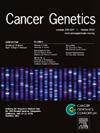6.与非 D816 KIT 变体相比,骨髓性肿瘤中的热点 D816 KIT 具有不同的临床结果
IF 1.4
4区 医学
Q4 GENETICS & HEREDITY
引用次数: 0
摘要
KIT(原癌基因)在髓系肿瘤(MNs)的诊断和预后中发挥着重要作用。世卫组织认为,外显子 17 中的热点 KIT D816 突变是伴有 RUNX1::RUNX1T1 的急性髓性白血病(AML)的不良预后标志,也是以肥大细胞克隆性增殖为特征的系统性肥大细胞增多症(SM)的诊断和预后标准之一。人们认识到密码子 816 以外的活化 KIT 突变的作用,因此在最新的 SM 诊断共识建议中增加了几个关键的 KIT 区域。然而,有关这些 "非热点 "变化对预后影响的信息却很有限。在此,我们以KIT D816的MNs患者(N=26)为对比组,比较分析了被诊断为KIT 816密码子外激活性变化的MNs患者(N=14)的临床病理和生存参数。大多数研究对象为急性髓细胞性白血病患者(65%),其次为骨髓增生异常综合症和骨髓增生异常综合症/骨髓增生异常性白血病患者(35%)。两个研究组的正常、非复杂和复杂核型以及诊断性 t(8;21) 和 inv(16) 核型的代表性相同。对 c-KIT (CD117) 进行 IHC 染色发现,非 D816 组肥大细胞中表达 c-Kit 蛋白的比例明显低于 D816 KIT 患者(p<0.0076)。与此相一致的是,非 D816 组患者中没有人发展为 SM,而 D816 组患者中有 31% 发展为 SM。值得注意的是,与 D816 变化的患者相比,非 D816 KIT 组患者的 OS 更好(p<0.016)。我们的结果支持了非D816 KIT突变对预后的影响弱于D816热点的假设。本文章由计算机程序翻译,如有差异,请以英文原文为准。
6. Hot-spot D816 KIT has different clinical outcome compared to non-D816 KIT variants in myeloid neoplasms
KIT (proto-oncogene) plays significant role in diagnosis and prognosis of myeloid neoplasms (MNs). The hot-spot KIT D816 mutation in exon 17 is recognized by WHO classification as poor prognostic marker for acute myeloid leukemia (AML) with RUNX1::RUNX1T1 and as one of diagnostic and prognostic criteria for systemic mastocytosis (SM), a MN characterized by clonal proliferation of mast cells. The role of activating KIT mutations outside of codon 816 was recognized, resulting in addition of few critical KIT regions in updated consensus proposal for SM diagnosis. However, information on prognostic weight of these 'non-hot-spot' changes is limited. Here we present results of comparative analysis of clinicopathological and survival parameters for patients diagnosed with MNs with activating KIT changes outside of codon 816 (N=14) using patients with MNs with KIT D816 (N=26) as comparative group. Most of study patients had AML (65%) followed by MDS and MDS/MPN (35% combined). Both study groups had same representation of normal, non-complex and complex karyotypes, and karyotypes with diagnostic t(8;21) and inv(16). IHC staining for c-KIT (CD117) detected significantly lower percentage of mast cells with c-Kit protein expression in non-D816 group in contrast to patients with D816 KIT (p<0.0076). Consistent with that, none of the non-D816 group patients developed SM compared to 31% of D816 group patients who developed SM. Notably, the group with non-D816 KIT showed better OS compared to patients with D816 change (p<0.016). Our results support the hypothesis of weaker prognostic impact of non-D816 KIT mutations compared to D816 hot-spot.
求助全文
通过发布文献求助,成功后即可免费获取论文全文。
去求助
来源期刊

Cancer Genetics
ONCOLOGY-GENETICS & HEREDITY
CiteScore
3.20
自引率
5.30%
发文量
167
审稿时长
27 days
期刊介绍:
The aim of Cancer Genetics is to publish high quality scientific papers on the cellular, genetic and molecular aspects of cancer, including cancer predisposition and clinical diagnostic applications. Specific areas of interest include descriptions of new chromosomal, molecular or epigenetic alterations in benign and malignant diseases; novel laboratory approaches for identification and characterization of chromosomal rearrangements or genomic alterations in cancer cells; correlation of genetic changes with pathology and clinical presentation; and the molecular genetics of cancer predisposition. To reach a basic science and clinical multidisciplinary audience, we welcome original full-length articles, reviews, meeting summaries, brief reports, and letters to the editor.
 求助内容:
求助内容: 应助结果提醒方式:
应助结果提醒方式:


